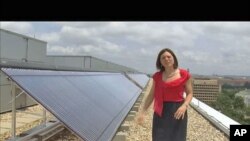More than 300 universities across the U.S. are turning green, meaning environmentally oriented. They are building sustainable facilities, renovating buildings, connecting solar and wind systems, planting organic gardens and reducing their overall carbon footprints. They also have initiated academic programs on environmental issues. Experts call it the largest transformation of colleges and universities in the last few decades.
George Washington University - in urban Washington, D.C. - is having a good strawberry harvest. The sunflowers grew back after the winter, and the zucchinis are looking good. Eloise Smith just graduated from GW and is looking after its community garden.
"These are the little squash blossoms," she said. "You pick the male ones because those aren’t the ones that will turn into the vegetable."
This is one of two gardens tended by student volunteers. But most important, this is only one of several sustainability programs at George Washington University.
There are new green buildings, which means they are built to affect the environment as little as possible. There are recycling programs, green roofs and even a GW television and multimedia show on the environment.
Meghan Chapple-Brown, director of Sustainability, said, "We've got an integrated system on this building and two other buildings that make the East Coast the largest array of solar hot water."
She said the greening of the university, now 10 years in the making, has evolved in three areas.
"Climate, water and eco-systems," said Chapple-Brown. "We have begun a great project on the ground that addresses climate change. We are planning on becoming carbon neutral and impact-reducing our foot print by 40 percent by 2025. So everything from there being solar hot- water systems on our rooftops, to making our building much more energy efficient."
The university is investing roughly $2 million on greening its campus. Some of the investments are already paying off with lower water and energy bills.
Sophie Waskow manages the Sustainability Office. "This is a rain barrel and is connected to a down spout from the roof of this residence hall," she said. The rain collectors here feed the greenery at the university and prevent more runoff into the Potomac River.
Chapple-Brown said the school, with 20,000 students, now offers 140 different courses on sustainability and the environment. She said prospective students have been key drivers of change.
"The other thing they are looking at is at the green aspects of the university. We know that is a really important factor and our students voice those concerns when they get here," Chapple-Brown.
More than two thirds of high school students consider a school's environmental performance when they select a university, according to the Sustainable Endowments Institute, a non-profit organization. Executive Director Mark Orlowski said that in the past five years, more than 300 colleges and universities around the country have moved toward sustainability.
“We have seen numbers like less than 20 percent of schools had a green building policy five years ago, and now upwards of 80 percent of schools having a policy, which states that their new building will be built in a green fashion,” said Orlowski.
Orlowski said colleges and universities around the world are starting to look into the economic aspects of greening campuses. He said students and universities are trying to meet today's needs without compromising future generations.











